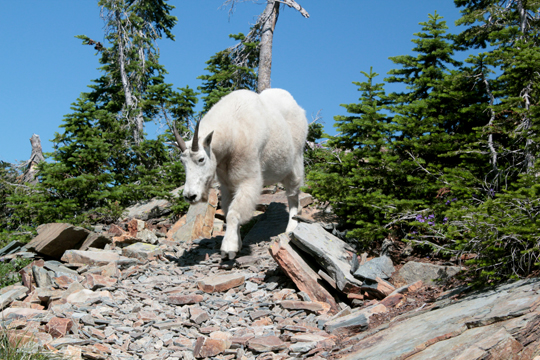
Lake Wildlife

Photo source: Lublyou
FROM MOUNTAIN GOATS to eagles, there is an abundance of wildlife in, around and on Lake Pend Oreille. The most abundant big raptor is the osprey, the large fish-eating hawk that is common around the lake. Ospreys nest in the tops of snags or power poles. The most visible ospreys are the pair nesting at the south end of the Long Bridge in Sandpoint.
Eagles are less plentiful, but there are a handful of nests around the lake. The best areas to spot eagles are Denton Slough and the Clark Fork River Delta.
Waterbirds – resident and migratory – are abundant. From exceedingly rare loons and western grebes to tundra swans, Canada and snow geese, countless ducks of more than a dozen species, heron, and thousands of coots, this lake plays host to a menagerie of waterbirds. More than 200 other species of birds have been counted around the lake. In addition to the Clark Fork Delta and Denton Slough, the Pack River Delta (10 miles east of Sandpoint via Idaho State Highway 200) and the Sunnyside-Oden Bay areas are good places to see waterfowl.
Finally, don't miss the mountain goats that inhabit Bernard Peak near Bayview on the south end of the lake. About 30 of them make their home on the rocky cliffs at Bernard Point near Echo Bay. They can be viewed quite close by boat or from across the bay in Farragut State Park's Willow Day Use Area, which has viewing scopes for the occasion. The goats were planted there in the 1960s from Snow Peak in the North Fork of the Clearwater, although old-timers have claimed they made their home on the cliffs before the 1910 fire swept through the area.
Lake Pend Oreille is a big lake and it harbors big fish. The largest taken from its depths was in 1994 by the late Jim Eversole. It was a mackinaw (also called lake trout) that weighed more than 43 pounds. The world record Kamloops, or Gerrard rainbow trout, was hauled in by Wes Hamlet in 1947 and pushed the scales to 37 pounds. Both of these species are recent transplants. Lake trout were planted here in the 1920s and the Kamloops were brought in from Kootenay Lake in British Columbia in the 1940s. One reason these sport fish reached such enormous proportions was their plentiful prey – kokanee. The kokanee population crashed in the 1990s. Subsequently, the kokanee fishery was closed in 2000.
Lake Pend Oreille is also an important stronghold for a char that is native to the watershed, but on the brink of extinction in much of its historic range – the beleaguered bull trout. Sometimes it is mistakenly called a Dolly Varden, the name of a related species. Though fishing for these giants is heavily controlled, they were once pulled from these waters by the multitudes. The largest bull trout on record to come from the lake weighed 32 pounds.
The lake is still home to native whitefish, northern pikeminnow, char and western slope cutthroat trout along with introduced species such as lake whitefish, and rainbow, brown and brook trout. Warmwater fishes also have been introduced, and include species like largemouth and smallmouth bass, northern pike, black crappie and yellow perch.
From the eagles and osprey that soar overhead to the deer that drink quietly at its shores; from the moose wading its shallows to the beaver plying its placid backwaters; from the mountain goats on Bernard Peak’s tattered cliffs to the fish swimming its shimmering depths, Lake Pend Oreille is vibrant with wildlife.